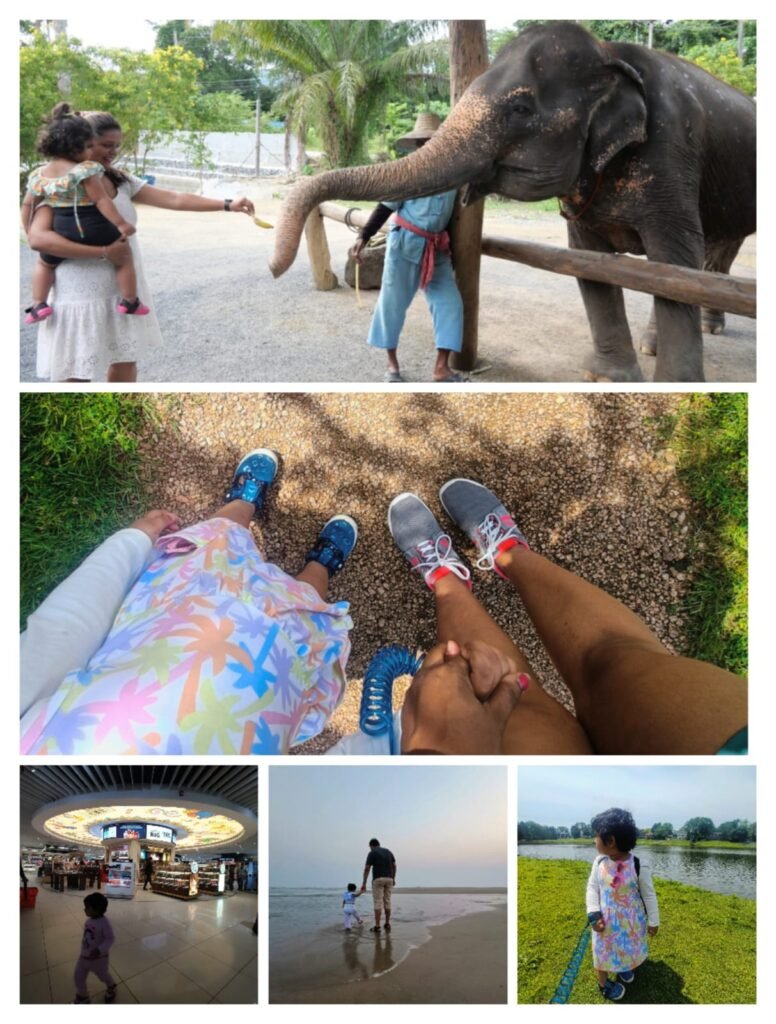Traveling with your child is a beautiful way to expose them to new cultures, experiences, and the wonders of the world. If you are on the fence, we urge you to first read our blog that addresses the million dollar question – Is Traveling with a Baby a Good Idea?
However, ensuring their safety in unfamiliar surroundings is a concern that many parents share. This guide aims to help you navigate those concerns with realistic, empathetic advice that balances protection with the freedom to explore.

1. Introducing “Good Touch, Bad Touch” with Sensitivity
Every parent’s goal is to keep their child safe while allowing them to enjoy the adventure of travel. A gentle, age-appropriate conversation about “good touch, bad touch” can give your child the tools they need to protect themselves without instilling fear.
- Start Simple and Clear: Begin by explaining that their body belongs to them and that they have the right to say “no” to any touch that makes them uncomfortable. Use language that matches their age and understanding, and reassure them that it’s okay to talk to you about anything that feels wrong.
- Role-Playing for Confidence: Practice scenarios where they might need to express their boundaries, such as if someone touches them in a way that feels uncomfortable. This helps reinforce the concept and gives them the confidence to act if needed.
- Reassure, Don’t Scare: Emphasize that while most people are kind and safe, it’s important to trust their feelings. Reinforce that they can always come to you, no matter what.
By approaching this topic with empathy and understanding, you empower your child to protect themselves while still feeling secure in their world.
2. Scream to Be Seen: Empowering Your Child to Speak Up
Teaching your child to use their voice is one of the most powerful safety tools you can provide. In crowded places or unfamiliar environments, the ability to draw attention to themselves can be crucial.
- Practice Together: Role-play scenarios where your child might need to shout for help, like if someone tries to lead them away from you. Encourage them to use loud, specific phrases like “This isn’t my dad/mom!” or “Help! I’m lost!” This not only alerts others but also deters potential wrongdoers.
- Emphasize Visibility: Teach your child the importance of staying in open, well-lit areas where they can easily be seen. If they feel uneasy, moving toward a crowd or finding a safe adult (like a police officer or store employee) can help them feel secure.
Encouraging your child to “scream to be seen” is about giving them a sense of control and agency, even in unfamiliar situations.
3. Parental Vigilance: Trusting Your Instincts
As parents, our instincts often guide us in ways that logic can’t. Staying vigilant while traveling doesn’t mean being constantly on edge, but rather, being aware of your surroundings and trusting your gut feelings.
- Stay Close, Stay Calm: In busy areas like airports or markets, it’s easy for children to wander off. Keep them within arm’s reach and establish a plan for what to do if you get separated. Remember to stay calm—your composure will help keep your child calm too.
- Know Your Environment: Before you travel, take some time to familiarize yourself with your destination. Identify safe areas, local emergency contacts, and the locations of nearby hospitals or police stations. This knowledge can be invaluable in an emergency. Also, it’s super helpful to familiarize yourself with some key emergency words in the local language along with the usual ones of greetings and gratitude.
- Use a Buddy System: If you’re traveling with multiple children, pairing them up can help ensure they always have someone looking out for them. This not only builds a sense of responsibility but also reduces the likelihood of anyone wandering off alone. For single kids, set up a buddy with ONE PARENT. This can be interchanged in short intervals, but make it loud and clear to the responsible parent and the child about who’s their buddy.
- Model Vigilance: Your child will take cues from you, so demonstrate the behaviors you want them to follow. Show them how to be aware of their surroundings and how to identify safe places and people. In this day and age, you should be extra careful of who’s focusing their smartphone at your kid and taking a video or photo, and train your child to do so too.
Vigilance is about balance—staying aware while still allowing room for fun and exploration.
4. No means No: Teaching Assertiveness with Compassion
Instilling the confidence to speak up when something feels wrong is a vital life skill. It’s not just about yelling for help; it’s about knowing when and how to assertively say “no.”
- Encourage Open Dialogue: Let your child know they can talk to you about anything, without fear of judgment or punishment. This openness builds trust and ensures they’ll come to you if something is bothering them.
- Empower Them to Say No: Teach your child that it’s okay to refuse anything that makes them uncomfortable, even if it’s from someone they know. Reinforce that they have the right to protect their personal space.
- Lead by Example: Show your child how to stand up for themselves and others in a respectful but firm way. Whether it’s addressing a minor issue or something more serious, your actions will guide their responses.
Learning to say no and mean it is perhaps the most crucial thing to teach to children in this day and age. Whether traveling to unknown lands or playing at the neighbours, this is a true and relatable life lesson for every child that a parent needs to teach, for raising strong humans.
Raising your voice against wrongdoers is about teaching your child to respect themselves and their boundaries, and to expect the same respect from others.
5. Staying Connected: Leveraging Technology for Peace of Mind
In today’s digital age, technology can be a powerful ally in keeping your child safe. Here’s how you can use it to stay connected and informed:
- Leashes and Handcuffs: Though it’s more visible and attracts attention and (often) ridicule from others, we have found these to be super helpful because you are always aware of the roundabouts of your child, while letting them explore on their own with the expandable cord, of 1.5 or 2 meters of distance. Easily available on amazon.com and amazon.in, these are truly lifesavers which come with a dash of fun.
- AirTags and GPS Trackers: Equip your child with a small GPS device like an AirTag in their backpack or shoe. This allows you to track their location in real time, providing peace of mind in busy or unfamiliar areas.
- Geo-Tagging for Safety: Use apps that allow you to set up geo-fenced areas. If your child leaves a designated safe zone, you’ll receive an immediate alert. This can be especially useful in large public spaces or while exploring new cities.
- Emergency Contact Information: Ensure your child has access to emergency contact information. You can program your phone number or a local emergency number into their device. Some smartphones also have emergency SOS features that can send alerts and location details to you at the press of a button.
By integrating technology into your safety plan, you add an extra layer of protection, allowing your child the freedom to explore while you maintain a watchful eye.
6. Respecting Cultural Traditions: Blending In for Safety
When traveling, respecting local customs and traditions is more than just good manners—it’s also a way to keep your family safe. Dressing and behaving in ways that align with the local culture can help you blend in and avoid unwanted attention.
- Research Before You Go: Different cultures have different expectations, especially regarding dress. Take the time to learn about these before you travel, and pack accordingly. For example, in more conservative countries, covering shoulders and knees may be expected.
- Dress Modestly: In many places, modest clothing can prevent misunderstandings or offense. Encourage your child to wear comfortable, appropriate clothing that reflects the local customs. This not only shows respect but also helps your family blend in more easily.
- Avoid Flashiness: Dressing in a way that draws less attention can also be a safety measure. Avoid flashy jewelry or expensive-looking accessories that might make you a target for theft.
By respecting the local culture, you enhance your family’s safety while also enriching your travel experience through deeper cultural immersion.
Final Thoughts: Balancing Safety with Adventure
Traveling with young children is a wonderful way to expand their horizons and create unforgettable memories. By teaching them about “good touch, bad touch,” encouraging them to “scream to be seen,” and leveraging modern technology, you can help ensure their safety without limiting their sense of adventure.
Your vigilance, combined with a respectful approach to local customs and a thoughtful use of technology, creates a strong foundation for safe and joyful travels. Remember, the goal is not to instill fear, but to empower your child with the knowledge and tools they need to stay safe, no matter where your journeys take you.
The world is beautiful, and our kids deserve to see, feel, and be part of it. Don’t you agree?







One Response